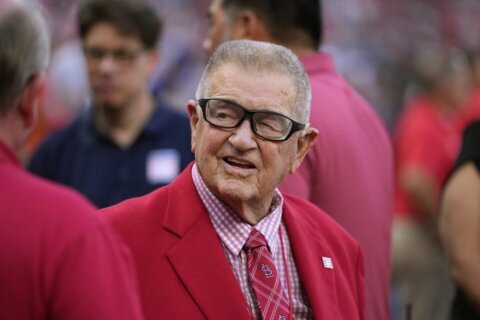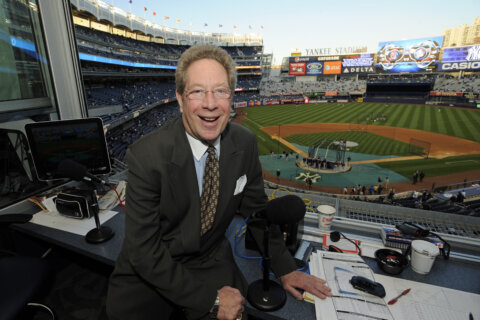NASHVILLE, Tenn. — It’s a high, bright overcast sky on a dreary Sunday morning in central Tennessee, one final step from a dream achieved, yet thousands of miles away. It’s not just the weather that makes this morning so sluggish — both the Triple-A Nashville Sounds and the visiting New Orleans Zephyrs traveled in overnight from out of town for Saturday night’s game. Then they played 18 innings.
That makes this mid-May Sunday what is commonly called a show-and-go game; no batting practice, no infield, just get to the park, throw on your unis and play. But two hours before first pitch, Pat Venditte, who tossed 2.2 spotless innings of relief to allow Nashville level the score and force extras the night before, is already in the clubhouse, drinking coffee, wearing a T-shirt with the name of his parent club, the Oakland Athletics.
“It would be nice — because I wasn’t supposed to be able to make it — if I could get there,” he muses about wearing the green and gold in Oakland. “And if I get there, stay as long as I can.”
If you’ve heard of Venditte, then you already know why he’s a significant player. That’s not a characterization attached to too many 29-year-old middle relievers who have toiled in the minor leagues for eight seasons without ever breaking through to The Show. But Venditte isn’t like many other veteran minor leaguers, or like many middle relievers, or like any other pitchers at all. That’s because Venditte pitches with both hands.
If you haven’t heard of Venditte, you likely will be inundated with his story this weekend. On Friday, he finally got the call every baseball player dreams of, to meet the A’s in Boston as they start a three-game series at Fenway Park.
* * *
When Venditte first pitches from both sides in an actual Major League game, he will be the first player to do so since 1995, when Montreal Expos hurler Greg Harris did against the Cincinnati Reds. But that was the only time Harris employed the tactic. To find another full-time switch pitcher in the Major Leagues, one has to look all the way to Cleveland. As in, the Grover Cleveland administration.
According to Major League Baseball historian Jerome Holtzman, the last regular switch pitcher to work in the big leagues was Tony Mullane, for Baltimore’s National League club in 1893. As the game has continued to become more and more specialized, with pitchers not even expected to bat at a respectable level anymore, the idea of such a throwback as Venditte is almost preposterous. Especially that such a player was drafted by the notoriously traditional, dogmatic New York Yankees.
Of course, he never broke into the big leagues in New York. It’s only fitting that Venditte finally make his debut with the experimental, out-of-the-box thinking, platoon heavy Athletics, with whom he signed a minor league deal this offseason.
“It definitely plays a role in deciding where you want to end up,” he said of Oakland’s dogma. “More than anything, I chose the team based on who I felt wanted me most. And I felt they thought that my skill-set would fit their organization. They were pretty excited about that, so that was an easy choice for me.”
* * *
In the made-for-Hollywood tale that has been Venditte’s life, much has been made of his mitt, as rare a commodity as the man himself. Symmetrical, with two sets of webbing, and room for six fingers (a thumb on each side), it is specially made by Mizuno in Osaka, Japan. But like Venditte, it is not unique. Harris used the same mitt when he switch pitched 20 years ago. That’s how Venditte’s father knew such a thing existed, and that he could procure one for his son.
Ironically, Venditte himself has come to resemble that symmetry more as his career has evolved. He used to have different pitch repertoires and deliveries from the two sides, a more traditional three-pitch arsenal with a low-90s fastball over the top from the right, with a sidearm, sinker/slider, high 80s fastball look from the left. But after having right shoulder surgery at the end of the 2012 season, he dropped down on that side as well and found he was more effective. Now, his motion is nearly identical from either side.
“That’s what they wanted,” Venditte says of the Yankees and pitching coordinator Gil Patterson. “I was throwing over the top before that, but after surgery (they) asked me to drop down sidearm to see if I could be a little bit more efficient getting right-handers out, and it’s worked out for me so far.”
Venditte has been very strong from the right side, holding opponents to a .208 batting average and allowing just one home run in 72 at-bats. But he’s been downright deadly against lefties, who are just 4-for-42 against him without an extra-base hit, just two walks and 13 strikeouts.
“As far as the velocity goes, if I was pitching over the top, I’m pretty close to where I was before, if not as good as I was before surgery,” he says, but acknowledges that he’s been more successful without the extra MPH. “Over the top I just don’t have as much success. I’ll wrinkle it in there every now and again just to keep them off balance.”
You know, as if throwing with both hands wasn’t enough to keep any lineup off balance.
But lest you begin to entertain thoughts of Venditte’s potential effectiveness as a starter, given his ability to theoretically throw twice as many pitches as your standard, one-armed thrower, he’s already recognized that even his versatile profile has its limitations.
“I’m at the mercy of their lineup,” he explains. “Last night, there were two lefties in the lineup, so a majority of my pitches were right-handed. And unless it’s stacked five and four, being a starter doesn’t present a whole lot of advantages to me. Technically it would work, but my skill-set doesn’t really allow for it.”
What it has allowed for, at last, is a chance to prove that the wild experiment his father set in place 26 years ago in his Omaha, Nebraska backyard worked.
“It’s been a long, long haul,” he laughs of his Odyssey through baseball’s minor leagues. “But I’m off to a good start so far this year. I just want to maintain it the rest of the season and see where it takes me.”
It’s taken him all the way to the top, at last.
https://www.youtube.com/watch?v=FtofU1hgf2w







